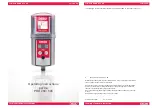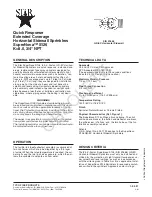
Fieldbus
Communication
•
119
ETHERNET
WAGO-I/O-SYSTEM 750
PROFINET IO
The advantage of this protocol is in the efficiency of the transmitted
data and the resultant increase in processing speed.
Many programs use both protocols. Important status information is
sent via the reliable TCP connection, while the main stream of data
is sent via UDP.
(3)
TCP, UDP
(2)
IP
(1)
Ethernet
(physical interface, CSMA/CD)
(4) Management, Diagnostic and Application Protocols:
Positioned above the TCP/IP stack or UDP/IP layer are correspondingly
implemented management, diagnostic and application protocols that provide
services that are appropriate for the application. For the management and
diagnostic, these are, for example, SMTP (Simple Mail Transport Protocol)
for e-mails, HTTP (Hypertext Transport Protocol) for www browsers and
some others.
In this example, the protocols MODBUS/TCP (UDP) and EtherNet/IP are
implemented for use in industrial data communication.
Here the MODBUS protocol is also positioned directly above TCP (UDP)/IP;
EtherNet/IP, on the other hand, basically consists of the protocol layers
Ethernet, TCP and IP with an encapsulation protocol positioned above it. This
serves as interface to CIP (Control and Information Protocol).
DeviceNet uses CIP in the same way as EtherNet/IP. Applications with
DeviceNet device profiles can therefore be very simply transferred to
EtherNet/IP.
Application device profiles
(e.g. positioning controllers, semi-
conductors, pneumatic valves)
CIP application objects library
CIP data management services
(explicit messages, I/O messages)
Ma
il client
WWW browser
...
CIP message routing, connection
management
CIP
(4)
SMTP
HTTP
...
MODBUS
Encapsulation
protocol
(3)
TCP, UDP
(2)
IP
(1)
Ethernet
(physical interface, CSMA/CD)
ETHERNET/IP
















































